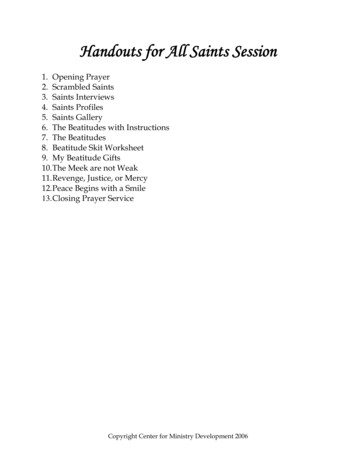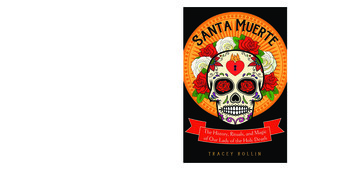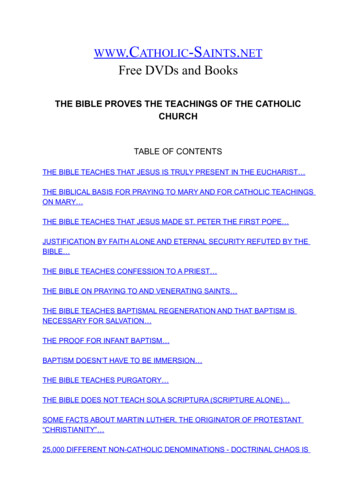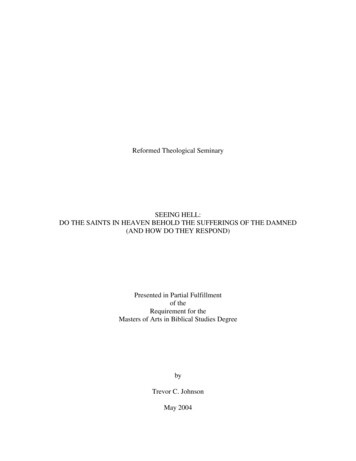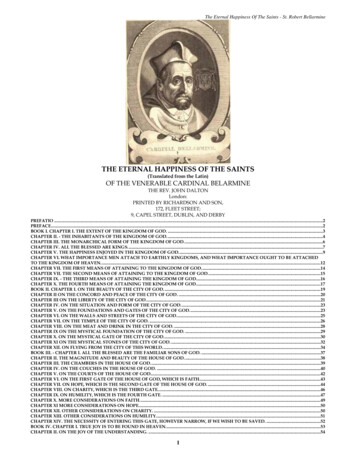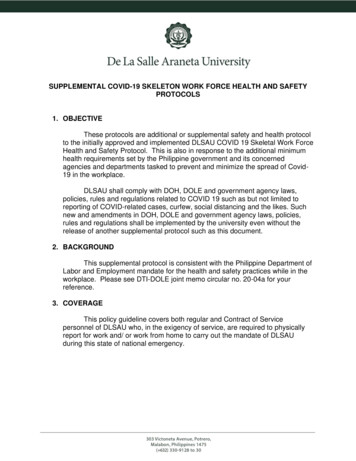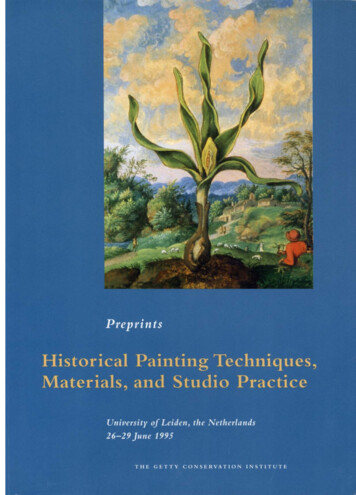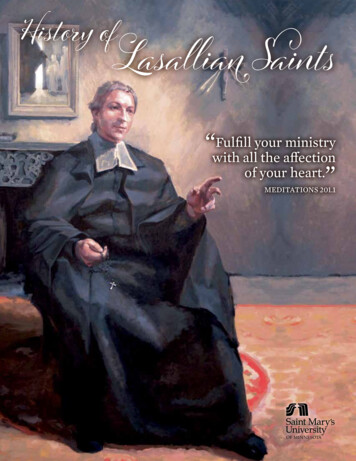
Transcription
History ofLasallian Saints“Fulfill your ministrywith all the affectionof your heart.”MEDITATIONS 201.1
History ofLasallian SaintsThe Catholic Church has been formallyrecognizing saints since the secondcentury, and becoming a saint means thatperson has lived and been recognized asleading an extraordinary, holy, Christianlife. Becoming a saint is a three-step processincluding first being named Venerable;meaning he or she exhibited heroic virtuesin their life. The second step is Beatification;before being beatified the person must havea miracle attributed to him or her. A martyrmay be beatified and declared "Blessed" byvirtue of martyrdom itself. Once a miracle isconfirmed, the person is known as Blessed.The third and final step before canonizationis having a second miracle attributed to hisor her intercession, unless he or she was amartyr. After these three steps, a person iscanonized and added to the list of saints.This timeline follows the journey of thesaintly Brothers of the Christian Schools andtheir feast days, beginning with our founder,Saint John Baptist de La Salle.AboutSaint Mary'sWe are a Lasallian Catholic universitythat is a living expression of the visionof John Baptist de La Salle, inspirational17th-century educational innovator, patronsaint of teachers and founder of the De LaSalle Christian Brothers: excellent qualityeducation; respect for the dignity of allindividuals; inclusive and participatorycommunity; interiority; accessibility;civility; innovation; belief in the presenceof a benevolent God; an ecumenical andinter-religious openness; solidarity with thepoor; and advocacy for those suffering frominjustices.2We do this as a proud partner with1,000 schools, agencies and universitiesthat constitute the worldwide Lasallianeducational network.Understanding the complex and evolvingnature of higher education in the 21stcentury, Saint Mary’s University iscommitted to addressing present-daychallenges by striving to remain affordablefor the families of our students and throughdistinctiveness in structure and fluidity inoperation.
This timeline first appeared in OutReach, a Christian Brothers Servicespublication, Vol. 7, No. 2, 2016. Reprinted with permission from Christian Brothers Services.
Saint John Baptist de La Salle (1651-1719)Patron of All Teachers of YouthCanonized May 24, 1900 - Feast day is April 7Born in Reims, France, on April 30, 1651, into a devoutand influential family, John Baptist de La Salle receivedthe tonsure at age 11 and was named Canon of the ReimsCathedral at 16. He completed his theological studies andwas ordained a priest on April 9, 1678. Two years later hereceived a doctorate in theology. Meanwhile he becametentatively involved with a group of rough and barelyliterate young men who wanted to establish schools forpoor boys. Almost by accident, the young De La Sallegradually assumed the leadership of the small groupof lay teachers. Moved by the plight of the poor whoseemed so "far from salvation" either in this world or thenext, he determined to put his own talents and advancededucation at the service of the children "often left tothemselves and badly brought up." To be more effective,he abandoned his family home, moved in with theteachers, renounced his position as Canon and his wealth,and so formed the community that became known as theBrothers of the Christian Schools.4His enterprise met opposition from the ecclesiasticalauthorities who resisted the creation of a new form ofreligious life, a community of consecrated laymen toconduct gratuitous schools "together and by association."The education establishment resented his innovativemethods and his insistence on gratuity for all, regardlessof whether they could afford to pay. Nonetheless De LaSalle and his Brothers succeeded in creating a networkof quality schools throughout France that featuredinstruction in the vernacular, students grouped accordingto ability and achievement, integration of religiousinstruction with secular subjects, well-prepared teacherswith a sense of vocation and mission, and the involvementof parents.In addition, De La Salle pioneered programs for traininglay teachers, Sunday courses for working young men,and one of the first institutions in France for the careof delinquents. Worn out by austerities and exhaustinglabors, he died on April 7, 1719, at Saint Yon near Rouenearly on Good Friday, only weeks before his sixty-eighthbirthday.
Timeline:The SaintsSaint Benilde RomançonSaint Miguel Febres CorderoSaint Mutien-Marie Wiaux1984 (October 21)1989 (December 10)(1805-1862) Feast day is August 13(1854-1910) Feast day is February 9(1841-1917) Feast day is January 30Saint Benilde RomançonSaint Benilde Romançon was born inSouthern France in 1805, and was quitean amazing student. By the time hewas just 14, the De La Salle ChristianBrothers utilized him as a substituteteacher for their grade school classes.He eventually joined the De La SalleChristian Brothers in 1820, and was agood grade school teacher and later ahigh school teacher for teens who hadnever attended school before. He wasa strict disciplinarian, had a strongreligious spirit and inspired manymen to join the De La Salle ChristianBrothers.Saint Miguel Febres CorderoSaint Miguel Febres Cordero wasborn in 1854 in Ecuador. His familywas prominent in politics and thoughhe was crippled from birth, he wasa good student who became a giftedteacher. In 1868, he became the firstEcuadorian De La Salle ChristianBrother, despite his family’s urgings,to pursue a different career. Overtime, he wrote many books and washonored for his scholarship by Ecuadorand Spain. His students admired hissimplicity, directness, concern for themand prayerfulness. He died in Spainin 1910 from pneumonia, and today,throughout the United States, severalSan Miguel Middle Schools that serveinner-city neighborhoods have beennamed after him as a tribute to his lovefor teaching and his good work withyoung students.Saint Mutien-Marie WiauxSaint Mutien-Marie Wiaux was bornLouis Wiaux in Belgium in 1841 wherehis father was a blacksmith and hismother helped run a café. LouisWiaux joined the De La Salle ChristianBrothers, took the name BrotherMutien-Marie and became a gradeschool music and art teacher. He spent58 years at the same school and wasknown and loved for his patience andreligious spirit.1967 (October 29)The Saints5
Timeline:Saint Jaime Hilario BarbalThe Saints1999 (November 21)The Saintly Martyrsof TurónSaint Solomon Le Clercq(1898-1937) Feast day is January 18(1934) Feast Day is October 9(1745-1792) Feast day is September 2Saint Jaime Hilario BarbalBorn Manuel Barbal Cosan, BrotherJaime grew up in Northern Spainand joined the De La Salle ChristianBrothers when he was 19. BrotherJaime had hearing difficulties, andafter teaching for 16 years he left theclassroom to work as a gardener at theyoung Brothers’ training center, knownas a House of Formation. A civil warbroke out in Spain in the 1930s and theCommunist Party that took controlblamed the Catholic Church for manyof Spain’s troubles. They arrested andkilled church leaders and BrotherJamie was among those to suffer thisfate in 1937. He refused to deny hisreligion, saying to the soldiers orderedto shoot him, “To die for Christ, myyoung friends, is to live.” When twovolleys failed to meet their mark, thesoldiers dropped their rifles and fled inpanic. The frustrated commander thenfired five shots at close range and killedBrother Jaime.The Saintly Martyrs of TurónThe Spanish Civil War of the 1930s wasboth political and religious, and manyin political power blamed the troublesof the country becoming more modernon the persuasion of religion. They alsofeared the influence religious leadershad on young people. In October1934, in the northwest Spanish villageof Turón, the De La Salle ChristianBrothers defied the ban on teachingreligion and openly escorted theirstudents to Sunday Mass. In an attemptto eliminate the religious zeal of the DeLa Salle Christian Brothers, the armyarrested them and their priest chaplain,and then shot them. Brother Cirilo, 46,was the director, Brother Marciano,39, was the cook, Brother Julián was32, and five other De La Salle ChristianBrothers were in their twenties.Saint Solomon Le ClercqSaint Solomon Le Clercq was bornin 1745, and was a devoted teacherand skilled financial manager for theDe La Salle Christian Brothers. Helived during the time of the FrenchRevolution, where the common peoplerose up against the royalty of Franceand established a more democraticform of government. As part of thisrevolution, the new leaders madetimes difficult for the official religion- Roman Catholicism and all Catholicorganizations became illegal. The DeLa Salle Christian Brothers and theirwork was almost fully dismantled asa result. The De La Salle ChristianBrothers refused to swear loyalty tothis new government, resulting in themhaving to live in secrecy. In 1792, SaintSolomon Le Clercq was arrested by thegovernment, imprisoned with severalother church leaders and was executedshortly after imprisonment.61999 (November 21)Saint Cirilo BertránSaint Marciano JoséSaint Julián AlfredoSaint Victoriano PioSaint Benjamin JuliánSaint Augusto AndrésSaint Benito de JesúsSaint Aniceto AdolfoSaint Inocencio de la ImmaculadaCanoure, CP2016 (October 16)
Timeline:The BlessedBlessed Arnold Rèche1989 (May 2)The Blessed Martyrsof Almeria(1838-1890) Feast day is October 23(1797-1867) Feast day is September 27(1936) Feast day is November 16Blessed Arnold RècheBlessed Brother Arnold Rèche wasborn in 1838 to a poor family in France.Growing up, he worked as a stableboy, coachman and constructionworker. He was drawn to the De LaSalle Christian Brothers because ofhis religious spirit and joined themin 1862, when he was 34. He learnedmath, science, agriculture and religionwhile teaching at a boarding school inReims, the town in which the founderof the De La Salle Christian Brothers,Saint John Baptist de La Salle, grewup. When France was at war in the1870s, he cared for the wounded fromboth sides. He had an amazing abilityto sense what others were thinkingand the De La Salle Christian Brothersremembered him saying often thatthe Holy Spirit of God “strengthensa person’s heart.” When he died inReims in 1890, he had a reputation forgreat holiness.Blessed Scubilion RousseauBlessed Brother Scubilion Rousseauwas born 1797. As a teenager, hevolunteered to teach religion classesand eventually joined the De La SalleChristian Brothers in Paris in 1822.When he was 36, he left France topursue missionary work. For the next34 years, Brother Rousseau workedamong the enslaved natives of theisland of Réunion off the coast ofMadagascar, and was dearly loved bythe people of this island nation for hiskindness and devotion to his students.He was primarily a catechist, a teacherof religion, but in his later years, hevisited the sick, won sinners over toChristianity and was highly respectedeverywhere on the island as a livingsaint among the people. He died in1867.1987 (November 1)Blessed Scubilion Rousseau1993 (October 10)The Blessed Martyrs of AlmeriaThe Catholic Church holds dearanyone who endures the loss oflife because of their Christianwitness. During the first centuriesof Christianity, this was the fate ofthousands of early followers of Jesus,and sadly, this has happened in everycentury since the time of Jesus. In the1930s, many were executed in Spainbecause they were religious leaders.In 1936, seven De La Salle ChristianBrothers in Almería, Spain, werearrested and condemned for teachingthe Catholic faith. They were:Brother José Cecilio Rodríguez GonzálezBrother Amalio Zariquiegui MendozaBrother Valerio Bernardo Herrero MartínezBrother Edmigio Primo RodríguezBrother Evencio Ricardo Alonso UyarraBrother Aurelio María Villalón AcebrónBrother Teodomiro Joaquin Sáiz SáizThe Blessed7
Timeline:The BlessedThe Blessed Martyrsof the RochefortThe Blessed Martyrsof ValenciaBlessed Leonardo José(1794) Feast day is September 2(1936) Feast Day is July 1(1886-1936) Feast day is November 6The Blessed Martyrs of theRochefort Brothers Roger, Léon andUldaric lived in France in the 1790s, theyears of revolution in that country. Allreligious leaders were required to signan oath of allegiance to the governmentwhich would be more binding on aperson than his or her allegiance tothe Catholic Church. Many priests,brothers and religious sisters refusedto sign such an oath. Some fled thecountry, some were arrested, put inprison and even tortured. In 1794, 827of these prisoners endured monthsof captivity on two boats –no biggerthan large pontoons. Brothers Roger,Léon and Uldaric were three of the542 who died on these boats as victimsof suffering for their faith during theFrench Revolution.The Blessed Martyrs of ValenciaFive De La Salle Christian Brotherslived in Spain during the days whenthe government was persecutingthose who were Christian, and oftenexecuting anyone who was a Christianleader. Brother Florencio Martín waskind, optimistic and talented in artand music. Brother Bertrán Francisowas steady, frugal, patient, modestand hard-working. Brother AmbrosioLeón was a competent, distinguishedand highly respected teacher. BrotherElias Julián was a simple person alwayswilling to serve. Brother HonoratoAndrés was quiet, thoughtful andunderstanding. These men had beenworking peacefully in the educationalministries of the De La Salle ChristianBrothers near Barcelona and because ofpersecution there, they fled to Valenciaso they could continue their service.When the authorities discoveredthese five were professed De La SalleChristian Brothers, they were arrestedand executed.1995 (October 1)82001 (March 11)2007 (October 28)Blessed Leonardo JoséBorn José María Aragonés Mateu inTarragona, Spain, on May 21, 1886.He studied at the seminary andwhile at the College of Tarragonadecided to become a Brother of theChristian Schools. In 1910, he enteredthe Novitiate in Burgos. He was sentto Catalonia, where he began hisapostolate and in 1914 was appointeddeputy director of a boarding school inBarcelona. In 1928, Brother Leonardobecame Brother Visitor of the District,where he served for eight years untilAugust 8, 1936, when he was detainedby the militia and executed. He wasbeatified in 2007 along with 487 othermartyrs of the Spanish Civil War.
Timeline:The BlessedBlessed Raphael-LouisRafiringa2009 (June 7)Blessed Brothers ofBarcelona2007 (October 28)The Blessed Brothers ofthe Community ofSanta Cruz de Mudela(Process of Ciudad Real)2007 (October 10)(1856-1919) Feast day is May 19(1936) Feast day is November 6(1936) Feast day is November 6Blessed Raphael-Louis RafiringaBlessed Brother Raphael-LouisRafiringa was born to an upper class,but pagan family in Antananarivo,Madagascar. At 10 years of age, he wasone of the first students at a schoolopened by the De La Salle ChristianBrothers in Madagascar. In 1869,he was baptized, in 1876 he enteredthe Institute of the Brothers of theChristian Schools and in 1879, he madethe Annual Profession. When theforeign missionaries were expelledfrom the island, he was electedChief of the Catholic Union for allMadagascar. He went on to teach,work, write and compose music. Hewas honored with the Medal of theCivil Merit for his successful efforts tonormalize relations between Franceand Madagascar.The Blessed Brothers of BarcelonaIn 1936, there were 32 Lasallianministries in Catalonia. All wereforcibly abandoned when the religiouspersecution became violent. Manywere pillaged and some burned. DeLa Salle Christian Brothers from 26communities were executed. BrotherLeonardo José, Visitor, and BrotherDionisio Luis, Director of the La SalleBononova College, were in the Cerdañaarea when they learned of the sadnews. They tried to get to Barcelonaand Cambrils to be close to the DeLa Salle Christian Brothers and tothose in formation, but were arrested,shot, and killed in Traverseras. Todaytheir remains are at San Martin deSasgayolas. The other 95 De La SalleChristian Brothers of the Districtsuffered the same fate. The youngestwas only 18 years old, while the oldestwas 60. Forty-four of these De La SalleChristian Brothers are included in thiscanonical process.The Blessed Brothers of theCommunity of Santa Cruz deMudelaIn 1936, Santa Cruz de Mudela was asmall town in the province of CiudadReal. There was a school run by five DeLa Salle Christian Brothers. In 1936,a group of militia overran the schooland arrested the De La Salle ChristianBrothers. They were taken to a prisonto be tormented and humiliated.Several times a day they were forcedto sweep the public square while beinginsulted and verbally abused. Forcedto do military marches while singingMarxist slogans, their faces wereslapped. A group of militia showed upand demanded to see the De La SalleChristian Brothers and other prisoners(including five priests) – all of whomwere executed at midnight in thecemetery at Valdepeñas.9
Timeline:The Blessed Brothers ofthe Community of Lorca(Process of Cartagena)The Blessed Brothers of the Processof Madrid n. 1 and Madrid n. 2(1936) Feast day is November 6(1936) Feast Day is November 62007 (October 28)The Blessed Brothers of theCommunity of LorcaFive De La Salle Christian Brotherswere in their community at the SanJosé elementary school in Lorca, atown in Murcia. In 1936, a group of20 militia invaded the house andsearched all of the rooms for weaponsand money. Finding neither, the militiaarrested the De La Salle ChristianBrothers anyway. After unsuccessfullybeing able to testify and be set free, theDe La Salle Christian Brothers weretaken to a mountain where there weresulphur mines. They were shot bymilitia and their bodies were throwninto a deep sulphur pool, now knownas the “pool of martyrs.”10The Blessed2013 (October 13)The Blessed Brothers of the Processof Madrid n. 1In the Griñón community, there was ajuniorate, novitiate, scholasticate anda house for sick De La Salle ChristianBrothers. One day, a group of militiainvaded the property. There were 10De La Salle Christian Brothers thereat the time. They were forced to lineup in front of the chapel while militiadestroyed sacred images, objects andfurniture. The De La Salle ChristianBrothers and a house employee wereexecuted because of their religiousbeliefs, their bodies left outside onthe ground. A group of townspeopleand a judge later helped identify thebodies and bury them on the De LaSalle Christian Brothers’ property.Included in this canonical processare eight other De La Salle ChristianBrothers from the Asilo SagradoCorazón community and three fromthe Camberi community.The Blessed Brothers of the Processof Madrid n. 2The community of Editorial Bruñowas a printing house that publishedtextbooks composed by De La SalleChristian Brothers but often usedin state schools. One day, a group ofcommunist militia went to the houseand pretended to inspect it lookingfor arms and money. This was only anexcuse. Without any explanation, theypushed the eight De La Salle ChristianBrothers who were there into a jeep,drove them to Casa de Campo (partof Madrid), and killed them. Alsoincluded in this canonical process areanother eight De La Salle ChristianBrothers from different communities.
Timeline:The BlessedThe Blessed Brothersof Tarragona2013 (October 13)The Blessed Brothers of TarragonaDe La Salle Christian Brothers in Tarragona from 1952-1959 belongedto different Brothers’ communities. When persecution became fierce,they were forced to find refuge wherever they could to avoid the dangerof being discovered or denounced. Six De La Salle Christian Brotherspretended to be tourists and took refuge at the National Hotel ofTarragona. They were discovered and executed together with the ownerof the hotel who had given them hospitality. An employee from the houseof the De La Salle Christian Brothers was forced to shoot two otherBrothers of Cambrils even though he refused. Other De La Salle ChristianBrothers were arrested and taken to prison where groups of them wereshot each day. There are 39 total De La Salle Christian Brothers includedin this canonical process.(1952-1959) Feast Day is November 6Timeline:The Servant of GodBrother James SantiagoMillerServant of God(1944-1982)Brother James Santiago MillerThe Vatican will formally hear thecause of the beatification of alumnusBrother James (Santiago) Miller,FSC ’66, M’74, in spring of 2018.An American missionary, BrotherJames was killed in Huehuetenango,Guatemala, on Feb. 13, 1982.Brother James is often rememberedfor the way his life ended. A lifeended too soon, Brother Jameswas only 37 when he was shot andkilled by three masked gunmenas he was mending a wall outsidea school where he worked. Aftergraduating from Saint Mary’s,Brother James taught high school inthe Midwest for several years beforegoing to Nicaragua and eventuallyGuatemala.At the Casa Indigena school, BrotherJames taught English, religion andGuatemalan art to secondary levelstudents. Aware of the oppression ofthe indigenous people of Guatemalaand their need to be trained injob skills and leadership skills,he helped begin an experimentalfarm where indigenous studentslearned agricultural methods andimprovements. More importantly,he prepared native leaders for ruralareas who would work for collectivedevelopment in their villages.The cause of beatification wasundertaken by the Diocese ofHuehuetenango, Guatemala, in 2009and received the Decree of Validityin Rome in July 2010 when BrotherJames was designated a “Servantof God” and a martyr for the faith.Because he is considered a martyr, amiracle would not be necessary forhis possible beatification, but will benecessary for canonization, or thefull declaration of sainthood.11
The Catholic Church has been formally recognizing saints since the second century, and becoming a saint means that person has lived and been recognized as leading an extraordinary, holy, Christian life. Becoming a saint is a three-step process including first being named Venerable;
